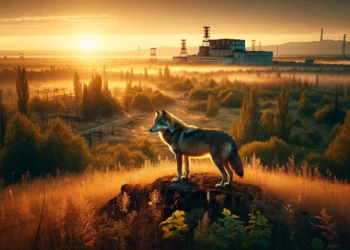In the wake of the Chernobyl nuclear power plant explosion in 1987, hundreds of thousand had to move immediately without notice. Their lives changed forever. Many didn’t have time to pack anything, as documented by the ghost towns around the fallout site still littered with toys, valuable items and other personal belongings. But while humans had much to suffer, the same can’t be said about the wildlife. In the almost four decades since the dramatic disaster, wildlife and vegetation has simply sprung to life like never before. In some instances, there are more wildlife per square meter than in some of the busiest protected natural parks in neighboring Belarus. Turns out wildlife doesn’t mind that much radiation – what they mind is humans.

The news was reported by a team of researchers who surveyed 1,600 square miles close to the Ukrainian-Belorussian border. The researchers used all sorts of methods to assess the mammal population from old school counting of tracks by foot, to helicopter observations, to camera traps. These went on for two years between 2008 and 2010. In 1987, shortly after the explosion at the nuclear power plant, scientists started counting wildlife and found populations were poor. Not necessarily because of the fallout, though, since the heavily industrialized area left little room for wildlife to expand. Since then, however, mammals have grown to impressive numbers. Within ten years, every animal population in the exclusion zone had at least doubled, all while animals in other former Soviet countries are on the demise at the hand of habitat loss, deforestation and over hunting. Take brown bears and the lynx, for instance. These haven’t been seen for decades before Chernobyl toppled. Now, they can easily be encountered.


According to the census, populations for most species were as large as in any of Belarus’ four national parks. With one notable exception, though: wolves. The apex predators were seven times more numerous. This is particularly telling since if there a lot of wolves, there should be a lot of food too: elk, boar, deer and so on, but also plants and insects. For instance, once busy Ukrainian towns are now in ruins, but the rust of socialist buildings has been offset by growing vines and whole forests. Nature has taken over, and all in a matter of decades. It’s quite impressive, the researchers report in Current Biology.
“What we do, our everyday habitation of an area – agriculture, forestry – they’ve damaged wildlife more than the world’s worst nuclear accident,” said Prof Jim Smith, professor of environmental science, University of Portsmouth, and one of the paper’s authors.
“It doesn’t say that nuclear accidents aren’t bad, of course they are. But it illustrates that the things we do everyday, the human population pressure, damages the environment. It’s kind of obvious but it’s an amazing illustration of it.”

What the study didn’t assess, however, was the individual health of animals. While the animals seem to be doing very well, the radiation fallout most certainly is affecting their biology. The explosion at the Vladimir Ilyich Lenin nuclear power plant released more radiation than the bomb dropped on Hiroshima, and thousands of humans were killed in the aftermath by radiation sickness and cancer over many years. Forest food products such as berries, mushrooms, and game contain particularly high levels of long-lived radioactive caesium and this contamination is expected to remain high for several decades.
“We can never trace back one disease to one single cause,” says Gerd Ludwig, a photographer who has been documenting the Chernobyl fallout for decades. “Even the numbers of people who will eventually die of cancer related diseases caused by Chernobyl are disputed–the UN initially put the number at 4,000, then 6,000, then 8,000. Now they’re at 9,000. Greenpeace and other reputable environmental agencies have put the numbers at 100,000 and more. Where the number really is, we will never know, because the 800,000 people that were brought in from all over the Soviet Union are dispersed back all over the former Soviet Republics. There is no record of who was there, who got sick and how. We will never know.”






